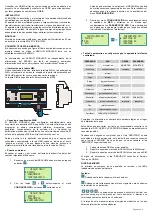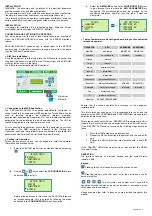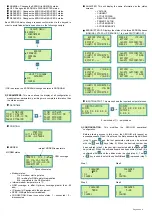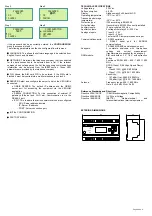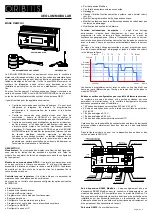
Página 1 de 6
XEOLUM MODULAR
INSTRUCTIONS ON USE
The XEOLUM MODULAR equipment is designed for remote control of
outside lighting, although its specifications enable it to be employed for
other generic functions in electric control boards. It provides the option of
incorporating a telemanagement system when required for installation
with or without a stabiliser-reducer.
Its operation requires the user to install a GSM data card. The XEOLUM
MODULAR is supplied with a set of three current transformers and a
GSM antenna.
It can be employed in the following applications:
•
Control centre without savings systems: alarms,
telemanagement. The alarms, astronomic clock programming,
consumption, voltage and auxiliary outputs can be integrated
and telemanaged.
•
Control centre with double level and control line: the XEOLUM
can configure the astronomical and reduced schedule
programming.
•
Control centre with voltage stabiliser-reducer unit: if any make of
voltage stabiliser-reducer unit is available, the above functions
can be applied. If the equipment is also an ESDONI, the
XEOLUM MODULAR allows the internal parameters to be
modified (stabilised voltage, maximum reducing and stepped
reducing by time periods), thus facilitating the adaptation of the
lighting to actual street requirements in a general manner as well
as on specific occasions, without any need to send a service
engineer to the installation.
DESCRIPTION
Display Unit:
this is a backlit display with four lines that shows system
data in real-time and can modify the equipment configuration by means
of the modules.
GPRS Communications Module:
this enables communication with an
external server via an IP address and make the equipment remotely
accessible using the GPRS mobile network. The mobile operator can be
freely selected by the client depending on available coverage in the area.
Regulator Local Control:
this is very useful for maintenance personnel
that do not have a laptop.
This control allows the following ESDONI options to be configured:
•
System status
•
Internal network analyser
•
Internal power meter
•
Operating mode programming and display
•
Savings per phase
•
System alarm configuration and display
•
System date, time and position programming and display
•
MODEM
•
IP server configuration
•
ModBus expansion port
•
Display connected external sensor status
•
Data logger
•
Change system operational status, normal mode, reduced and test
etc
•
Change astronomical clock programming
•
Modify the voltages for the various periods of reducing and the start-
up times
•
Modify the alarm warning thresholds
Incorporated astronomical clock function:
The equipment includes a
built-in astronomical clock that allows the time zone to be automatically
programmed by entering the geographical coordinates. Because of the
independence from a central server, operation is guaranteed in case of
network connection loss. System time can be set from the central.
This astronomical clock enables start-up levels, switch-off and up to four
levels of reducing to be programmed, as shown in the figure below.
The times to be programmed are dawn, dusk or fixed, with fixed being a
time that is referenced by the clock in the XEOLUM module in real-time.
Configurable inputs and outputs for controlling external elements:
The system is fitted with auxiliary inputs and outputs that permit
monitoring and control of any external equipment required by the
installation:
•
10 opto-coupled digital inputs, 230 Vac,
E01
to
E10
•
4 digital outputs with relays incorporated (voltage-free contacts).
S01
to
S04
•
1 analogue input, 0-10 V.
•
1 analogue input, 0-20 mA.
•
1 external NTC temperature sensor input.
These provide the option to connect external luminosity sensors that are
usually used inside tunnels or interior installation.
The following figure shows the XEOLUM module input and output
arrangement.
RS485 ModBus Expansion Port:
the system also includes an RS485
ModBus expansion port for connecting compatible I/O expansion
equipment or modules with ModBus protocol. This bus allows the
number of inputs and output to be increased in installations require extra
elements for technical or functional reasons that the controller does not
directly provide or which may be needed in the future.
RS232 Serial Port:
For external module.
Communications options:
There are several communications options,
such as:
•
Ethernet
•
Fibre
optics
Check with ORBIS for the type of communications that best adapts to
your system. The default configuration is GPRS. Please contact ORBIS
for other options.
XEOLUM MODULAR
GSM ANTENNA
CURRENT TRANSFORMERS
ENTER
ESC
IR
ON
GSM
SERVIDOR
ERROR
1
2
3
4
5
6
7
C
8
9 10 C
L
N
230V AC
ENTRADAS 230V - AC
R
S
T
R S T
-
+
TENSIONES (V)
CORRIENTE (I)
R
S
T
R S T
+
-
TENSIONES (V)
CORRIENTE (I)
SALIDAS 230V - AC
A B G
Tx Rx
G
RS485-1
RS485-2
RS232
GND
-
+
A B G
0-
10
V
0-
20
m
A
+5
V
NT
C
1
2
3
4
A1
A2
N
RS-485 EXPANSION
OUTPUT VOLTAGE
AUXILIARY
INPUTS
INPUT VOLTAGE
AUXILIARY
OUTPUTS
RS-485 ESDONI
0-10 V
0-20 mA
NTC
POWER SUPPLY
RS-232 EXPANSION
OUTPUT CURRENT
TRANSFORMERS
INPUT CURRENT
TRANSFORMERS
ANTENNA CONNECTOR
STATUS
LEDs
SCREEN
KEYPAD
Switch-on
T1
T2
T3
T4
T5
T6
Switch-off
Vout AC
Time
Dawn
Dusk
Nominal
Start-up
Reducing level 1
Reducing level 2
Reducing level 3
Reducing level 4


